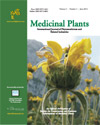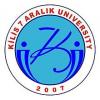The presented papers during the 7th Global summit on Medicinal and Aromatic Plants will be published in the,
Medicinal Plants - International Journal of Phytomedicines and Related Industries





- All portions of the manuscript must be typed double-spaced and all pages numbered starting from the title page.
- The Title should be a brief phrase describing the contents of the paper. The Title Page should include the authors' full names and affiliations, the name of the corresponding author along with phone, fax and E-mail information. Present addresses of authors should appear as a footnote.
- The Abstract should be informative and completely self-explanatory, briefly present the topic, state the scope of the experiments, indicate significant data, and point out major findings and conclusions. The Abstract should be 100 to 200 words in length. Complete sentences, active verbs, and the third person should be used, and the abstract should be written in the past tense. Standard nomenclature should be used and abbreviations should be avoided. No literature should be cited.
- Following the abstract, about 3 to 10 key words that will provide indexing references should be listed.
- A list of non-standard Abbreviations should be added. In general, non-standard abbreviations should be used only when the full term is very long and used often. Each abbreviation should be spelled out and introduced in parentheses the first time it is used in the text. Only recommended SI units should be used. Authors should use the solidus presentation (mg/ml). Standard abbreviations (such as ATP and DNA) need not be defined.
- The Introduction should provide a clear statement of the problem, the relevant literature on the subject, and the proposed approach or solution. It should be understandable to colleagues from a broad range of scientific disciplines.
- Materials and methods should be complete enough to allow experiments to be reproduced. However, only truly new procedures should be described in detail; previously published procedures should be cited, and important modifications of published procedures should be mentioned briefly. Capitalize trade names and include the manufacturer's name and address. Subheadings should be used. Methods in general use need not be described in detail.
- Results should be presented with clarity and precision. The results should be written in the past tense when describing findings in the authors' experiments. Previously published findings should be written in the present tense. Results should be explained, but largely without referring to the literature. Discussion, speculation and detailed interpretation of data should not be included in the Results but should be put into the Discussion section.
- The Discussion should interpret the findings in view of the results obtained in this and in past studies on this topic. State the conclusions in a few sentences at the end of the paper. The Results and Discussion sections can include subheadings, and when appropriate, both sections can be combined.
- The Acknowledgments of people, grants, funds, etc should be brief.
- Tables should be kept to a minimum and be designed to be as simple as possible. Tables are to be typed double-spaced throughout, including headings and footnotes. Each table should be on a separate page, numbered consecutively in Arabic numerals and supplied with a heading and a legend. Tables should be self-explanatory without reference to the text. The details of the methods used in the experiments should preferably be described in the legend instead of in the text. The same data should not be presented in both table and graph form or repeated in the text.
- Figure legends should be typed in numerical order on a separate sheet. Graphics should be prepared using applications capable of generating high resolution GIF, TIFF, JPEG or Powerpoint before pasting in the Microsoft Word manuscript file. Tables should be prepared in Microsoft Word. Use Arabic numerals to designate figures and upper case letters for their parts (Figure 1). Begin each legend with a title and include sufficient description so that the figure is understandable without reading the text of the manuscript. Information given in legends should not be repeated in the text.
- References In the text, a reference identified by means of an author's name should be followed by the date of the reference in parentheses. When there are more than two authors, only the first author's name should be mentioned, followed by ’et al‘. In the event that an author cited has had two or more works published during the same year, the reference, both in the text and in the reference list, should be identified by a lower case letter like ’a‘ and ’b‘ after the date to distinguish the works.
Examples :
Abayomi (2000), Agindotan et al. (2003), (Kelebeni, 1983), (Usman and Smith, 1992), (Chege, 1998; Chukwura, 1987a,b; Tijani, 1993,1995), (Kumasi et al., 2001)
References should be listed at the end of the paper in alphabetical order. Articles in preparation or articles submitted for publication, unpublished observations, personal communications, etc. should not be included in the reference list but should only be mentioned in the article text (e.g., A. Kingori, University of Nairobi, Kenya, personal communication). Journal names are abbreviated according to Chemical Abstracts. Authors are fully responsible for the accuracy of the references.
Examples
Ogunseitan OA (1998). Protein method for investigating mercuric reductase gene expression in aquatic environments. Appl. Environ. Microbiol., 64: 695–702.
Gueye M, Ndoye I, Dianda M, Danso SKA and Dreyfus B (1997). Active N2 fixation in several Faidherbia albida provenances. Ar. Soil Res. Rehabil., 11: 63-70.
Charnley AK (1992). Mechanisms of fungal pathogenesis in insects with particular reference to locusts. In: Lomer CJ, Prior C (eds) Biological Controls of Locusts and Grasshoppers: Proceedings of an international workshop held at Cotonou, Benin. Oxford: CAB International, pp 181-190.
Mundree SG and Farrant JM (2000). Some physiological and molecular insights into the mechanisms of desiccation tolerance in the resurrection plant Xerophyta viscasa Baker. In Cherry et al. (eds) Plant tolerance to abiotic stresses in Agriculture: Role of Genetic Engineering, Kluwer Academic Publishers, Netherlands, pp 201-222.
Editor-in-Chief
Veena Gupta
Conservation Division
National Bureau of Plant Genetic Resources, Delhi - 110 012
e-mail : veena@nbpgr.ernet.in
(Ph. : 91-9810911615)
Executive Editors
SK Prabhuji
Director, Biotechnology and Molecular Biology Centre
M.G. Postgraduate College, Gorakhpur - 273 001, UP, India
e-mail : shaktiprabhuji@rediffmail.com
(Ph. : 91-9839229079)
GP Rao
Principal Scientist
Division of Plant Pathology
Indian Agricultural Research Institute, Delhi - 110 012, India
e-mail : medplantjour@gmail.com
(Ph. : 91-9711763384)
AR Nautiyal
Director
High Altitude Plant Physiology Research Centre
HNB Garhwal University, Srinagar, Garhwal - 246 174
Uttarakhand, India
e-mail : arnautiyal@gmail.com
(Ph. : 0-9412921400)
T Sekar
Department of Botany, Pachaiyappa?s College
Chennai - 600 030, Tamil Nadu
e-mail : tsekar_bot@yahoo.com
(Ph. : 0-9444350858)
SS Deokule
Professor and Head
Department of Botany, University of Pune, Pune - 411 007
e-mail : deokule@unipune.ac.in
(Ph. : 0-9371088210)
SK Tewari
Scientist
National Botanical Research Institute
Rana Pratap Marg, Lucknow - 226 001
e-mail : tewarinbri@yahoo.co.in
(Ph. : 0522-2297961)
Managing Editor
Ashok Datta
A-155, Ashok Vihar, Phase-IV, New Delhi ? 110 052, India
e-mail : smediplants@yahoo.com
(Ph. : 91-9818412122)
Production Editor
D Reema
A-155, Ashok Vihar, Phase-IV, New Delhi ? 110 052, India
e-mail : smediplants@yahoo.com; daffodil.reema@yahoo.com
(Ph. : 91-8802467671)
Advisory Board | |
AK Bhatnagar, Delhi, India | SK Pareek, New Delhi, India |
TS Nayar, Kerala, India | P Pushpangadan, Kerala, India |
Balasubramanian, Chennai, Tamil Nadu | RD Gaur, Garhwal, India |
AB Singh, Delhi, India | V Sivaram, Bangalore, India |
M Ramesh, Karaikudi, Tamil Nadu | S Edison, Kerala, India
|
AH Munshi, Srinagar (J&K), India
|
|
|
|
Editorial Board | |
Fabrice F Boyom, Cameroon | Vineeta Rao, Gorakhpur, India |
DB Olufolaji, Akure, Nigeria | DP Semwal, Delhi, India |
Harikesh B Singh, Varanasi, India | RS Ramasamy, Chennai, India |
Priyanka Singh, Lucknow, India | VN Pandey, Gorakhpur, India |
MI Nasr, Menofia, Egypt | N Raaman, Chennai, India |
Rana P Singh, Lucknow, India | G Mukherjee, Kolkata, India |
Rakesh Pandey, Lucknow, India | RC Sundriyal, Gopeshwar, Uttarakhand, India |
MC Nautiyal, Srinagar, India | P Suprasanna, Mumbai, India |
AK Tiwari, Shahjahanpur, India | RC Gupta, Medziphema, India |
SK Tewari, Lucknow, India | Manoj K Dhar, Jammu, India |
Galip Akaydin, Ankara, Turkey | SK Sinha, USA |
Wandee Gritsanapan, Bangkok, Thailand | George Asare, Accra, Ghana |
Gurley Jr , Billy J, USA | AK Dwivedi, Lucknow, India |
Anupam Dikshit, Allahabad, India |
|
Indexed/Abstracted - Index Copernicus International(2016, ICV- 106.50), NAAS Rating for 2017 - 5.12, SCOPUS, EMBASE, MIAR(ICDS - 7.4), Indian Citation Index, InfoBase Index (IB Factor - 3.1), Indian Science Abstract, MAPA, Google Scholar, CAB Abstract, J-Gate, EBSCO Discovery, Summon(ProQuest), Primo and Primo Central, Agricola, Indian Science, Cite Factor, DRJI, ISRA-JIF, I2OR, ESJI, EZB and IIJIF.













